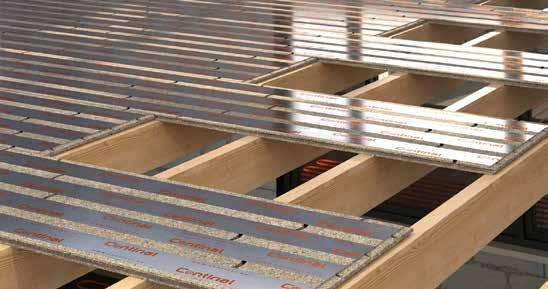
2 minute read
Mix and match for a perfect result
Building Regulations changes have made low-temperature heating systems mandatory in new-build and some renovation projects. But there’s no reason for heating engineers to be daunted by the move, writes Chris
Updated Building Regulations
Part L have mandated maximum flow temperatures of 55°C where possible for all new heating systems in England and Wales. This applies to systems in new-builds, as well as those being fitted to replace an existing heating system. It’s a significant reduction from the 80°C flow temperatures to which many are accustomed.
If the projects you work on now fall under the scope of these Part L changes, you will need to make sure you comply with them. It’s a real change if you’re used to fitting radiator-led domestic heating systems, and you may also have to explain to your customers why you need to make some updates to the heating system in their home.
A successful low-flow temperature system requires heat emitters with a much greater surface area than more traditional high-flow temperature versions. Achieving sufficient heat outputs at 55°C using radiators means you would probably have to fit extra or bigger radiators in each room – something that your customer may not want because it may restrict their options on décor and where they put their furniture.
Ingram, founder
of
Continal.
But replacing radiators with underfloor heating (UFH) turns the whole floor into a giant heat emitter, creating a more efficient, low-temperature system and maximising the living space. Because UFH systems are low temperature by design, installing them ensures compliance with the regulations, which is why it is the most practical and efficient heat emitter for almost any project.
If you’ve never fitted UFH before but regularly work on larger retrofit or new-build projects, the change might seem daunting. But there’s no need to worry: switching to UFH is simple and there is plenty of support if you’re not sure where to begin.
It’s not only those projects that must comply with the new Part L regulations that can benefit: UFH is a proven heating technology be fitted in homes that aren’t undergoing a complete rip-out, with the UFH designed to work alongside an existing radiator system. This type of split system can be the answer for projects where some rooms or floors have radiators, while other rooms (perhaps as part of an extension, or those with little wall space and larger floor areas) use UFH. Both heat emitters then work together.
In retrofit projects, UFH is easy to install without having to dig up the property’s entire floor: overfloor and suspended floor systems can be laid over the existing floor without adding significantly to its height.
Seek expert advice
Continal’s UltraSlim has a depth of just 15mm and can be used in almost any retrofit or new-build project. SlimFix has an 18mm depth from a composite panel with a heat-dissipation layer, which maximises heat output and temperature variance. These low-profile solutions are responsive, efficient and have minimal impact on floor heights, and they can be mixed and matched with other system types, depending on the floor covering required.
that homeowners have been embracing for decades. It can also be up to 30 per cent more efficient than radiators, depending on the heat source, so homeowners who make the switch can save money on their energy bills.
The flexibility of UFH is another factor in its favour because it can
Adjusting
to Building
Regulations changes can be daunting. While these latest updates may mean you have to consider alternatives to the products you have used previously, it will be an easy transition. Keeping up to date with all the changes also means you can better support your customers and reassure them that their property is fully compliant with the latest regulations.
For UFH on a first or second floor, the OneBoard system (pictured) can be installed directly on to joists in place of standard structural flooring panels.
Always choose an UFH supplier that will support you right through a project, from the first enquiry through to the final commissioning – and beyond. ■ www.continal.co.uk
0333 800 1750 www.continal.co.uk




